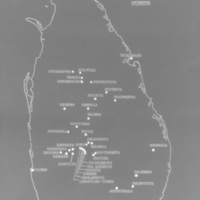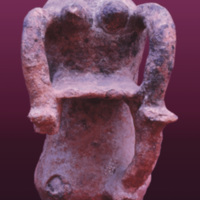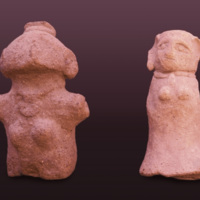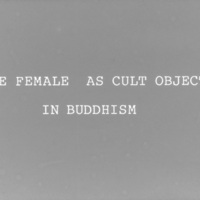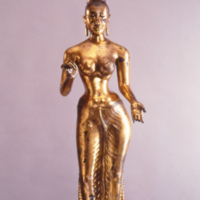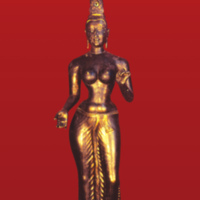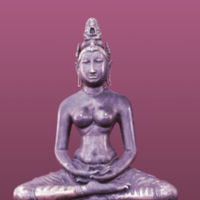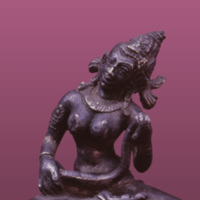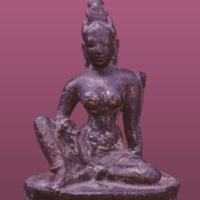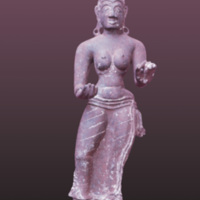Main Menu
AORC Libraries
Browse Items in Women in Sri Lankan Sculpture and Painting (166 total)
Reference map of Sri Lanka
Description: This map of Sri Lanka shows the location of art objects in the present collection.
Contributor: Co-Author: Seneviratna, Harsha
Collection: Women in Sri Lankan Sculpture and Painting
Mother goddess
Description: Among the earliest religious concepts associated with agricultural societies is the worship of the Mother Goddess, an ideology which cuts across many cultures. This image of the Mother Goddess from Killinochchi, Sri lanka, presently in the Archaeological Museum at Anuradhapura, Sri Lanka, represents a religious belief which is thought to date back to pre-Buddhist times. Provided with a ledge for offerings, it is one of the larger size images found in Sri Lanka. Unfortunately, none of the terra-cotta images of the Mother Goddess have been found in a datable context. Archaeologists believe that the cult worship of the Mother Goddess belongs to a wide span of time from ca. 4th century B.C. to the 12th century A.D.
Contributor: Co-Author: Seneviratna, Harsha
Collection: Women in Sri Lankan Sculpture and Painting
Mother goddess
Description: These two images are typical examples of the Mother Goddess. Her worship remained part of folk religion. Archaeologists assign a long time span from ca. 4th century B.C.-12th century A.D.
Contributor: Co-Author: Seneviratna, Harsha
Collection: Women in Sri Lankan Sculpture and Painting
The female as cult object in Buddhism
Description: The female as cult object in Buddhism: The well known text titled Sādhanamālā provides an early description of the female as cult object in Buddhism. Sādhanamālā edited by Bhattacharya and published by Baroda in 2 volumes, 1925-1928.
Contributor: Co-Author: Seneviratna, Harsha
Collection: Women in Sri Lankan Sculpture and Painting
Tara, guilded bronze image
Description: The major religious influence in Sri Lanka was Theravada Buddhism which provided no scope for any being other than the Buddha to be worshipped as cult object. However, the country did feel the impact of the Mahayana and Tantrayana forms of Buddhism where Buddhas, Bodhisattvas and their female elements or saktis and consorts were worshipped. It is in the context of these two systems that one finds the elevation of the female as cult object within Buddhist ideology, and the visual expression of that concept in art. Whether as the consort of a Bodhisattva or as Bodhisattva herself, the goddess in Mahayana worship is known as Tara. The best illustration of this goddess in Sri Lankan art is the well-known guilded bronze image, now in the British Museum. Art historians have suggested dates between the 8th and 10th centuries A.D., a period during which Mahayana and Tantrayana forms of Buddhism were felt in Sri Lanka.
Contributor: Co-Author: Seneviratna, Harsha
Collection: Women in Sri Lankan Sculpture and Painting
Tara, a replica
Description: This is a replica of the British Museum image of Tara. The unadorned, yet aesthetically pleasing image, wears a high hair-do, at the centre of which is an empty socket. It may have contained a miniature seated Buddha statue traditionally associated with Bodhisattva images. Originally found near Trincomalee, Sri Lanka, it is the tallest Buddhist female bronze image discovered in Sri Lanka and may represent an instance where Tara was worshipped in her own right as Bodhisattva. Various dates between the 8th and 10th centuries A.D. have been suggested by scholars. This replica is found in the National Museum, Colombo.
Contributor: Co-Author: Seneviratna, Harsha
Collection: Women in Sri Lankan Sculpture and Painting
Silver statue is of Tara
Description: Originally from the Gangaramaya temple in Kurunegala, Sri Lanka, this seated silver statue of Tara. She sits in meditation, a rare pose for Tara images. Except for certain head ornaments and an empty socket in her hair arrangement which could have contained a Buddha statue, she wears no other adornments. Art historians have ascribed the image to about the 8th century A.D. on stylistic grounds. This statue is found in the National Museum, Colombo.
Contributor: Co-Author: Seneviratna, Harsha
Collection: Women in Sri Lankan Sculpture and Painting
Silver alloy statue of Tara
Description: This miniature silver alloy image of Tara in the Anuradhapura Archaeological Museum has been identified as ‘Janguli Tara’, the goddess who protects people from calamities such as snake-bite. She carries a cobra in her hand and has four seated Buddhas carved round her head-dress. It was discovered near Mannar, Sri Lanka. It may be ascribed to the 8th to the 10th century period, the heyday of Mahayana Buddhism in Sri Lanka according to historians.
Contributor: Co-Author: Seneviratna, Harsha
Collection: Women in Sri Lankan Sculpture and Painting
Bronze image of Tara
Description: Housed in the Archaeological Museum, Anuradhapura, Sri Lanka, is this miniature bronze of Tara seated in a partly cross-legged posture known as ‘ardhaparyanka’. Her right hand is broken and so is the flower which seems to have rested against her, of which only the stalk remains. The statue is dated to about the 9th century A.D. on stylistic grounds.
Contributor: Co-Author: Seneviratna, Harsha
Collection: Women in Sri Lankan Sculpture and Painting
Bronze statue of Tara
Description: Among the Mahayana bronze images found at Tiriyay, Sri Lanka, is this standing statue of Tara now exhibited in the Colombo National Museum. She wears some ornaments, but on the whole there is a total lack of ostentation. This image at Tiriyay, Sri Lanka, is dated to the late Anuradhapura period (9th to the 10th centuries A.D.), when the worship of Mahayana gods and goddesses was popularly practiced according to historians.
Contributor: Co-Author: Seneviratna, Harsha
Collection: Women in Sri Lankan Sculpture and Painting



